brakes CADILLAC STS 2009 1.G Owners Manual
[x] Cancel search | Manufacturer: CADILLAC, Model Year: 2009, Model line: STS, Model: CADILLAC STS 2009 1.GPages: 514, PDF Size: 2.73 MB
Page 102 of 514
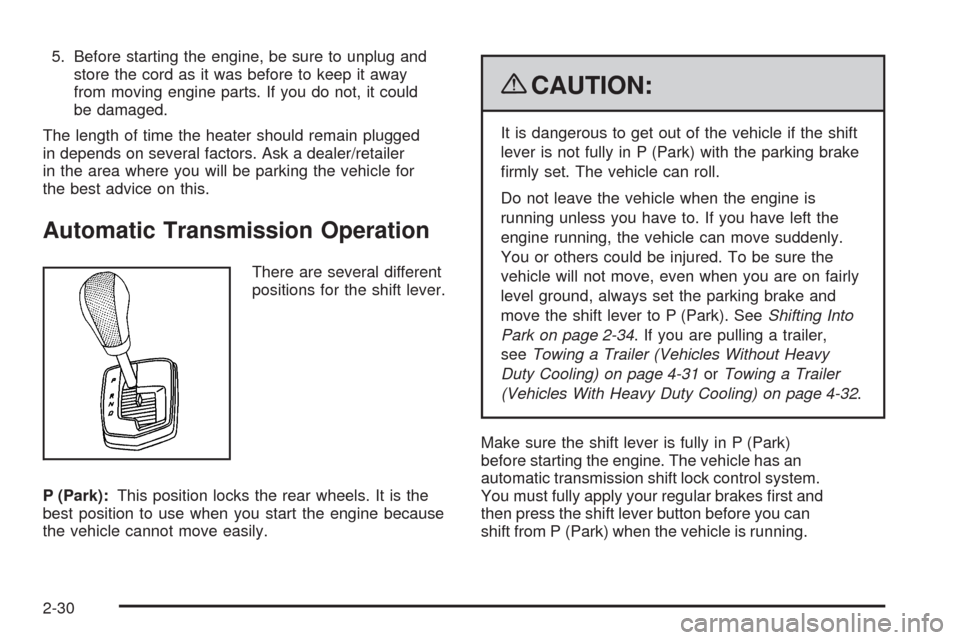
5. Before starting the engine, be sure to unplug and
store the cord as it was before to keep it away
from moving engine parts. If you do not, it could
be damaged.
The length of time the heater should remain plugged
in depends on several factors. Ask a dealer/retailer
in the area where you will be parking the vehicle for
the best advice on this.
Automatic Transmission Operation
There are several different
positions for the shift lever.
P (Park):This position locks the rear wheels. It is the
best position to use when you start the engine because
the vehicle cannot move easily.
{CAUTION:
It is dangerous to get out of the vehicle if the shift
lever is not fully in P (Park) with the parking brake
�rmly set. The vehicle can roll.
Do not leave the vehicle when the engine is
running unless you have to. If you have left the
engine running, the vehicle can move suddenly.
You or others could be injured. To be sure the
vehicle will not move, even when you are on fairly
level ground, always set the parking brake and
move the shift lever to P (Park). SeeShifting Into
Park on page 2-34. If you are pulling a trailer,
seeTowing a Trailer (Vehicles Without Heavy
Duty Cooling) on page 4-31orTowing a Trailer
(Vehicles With Heavy Duty Cooling) on page 4-32.
Make sure the shift lever is fully in P (Park)
before starting the engine. The vehicle has an
automatic transmission shift lock control system.
You must fully apply your regular brakes �rst and
then press the shift lever button before you can
shift from P (Park) when the vehicle is running.
2-30
Page 116 of 514
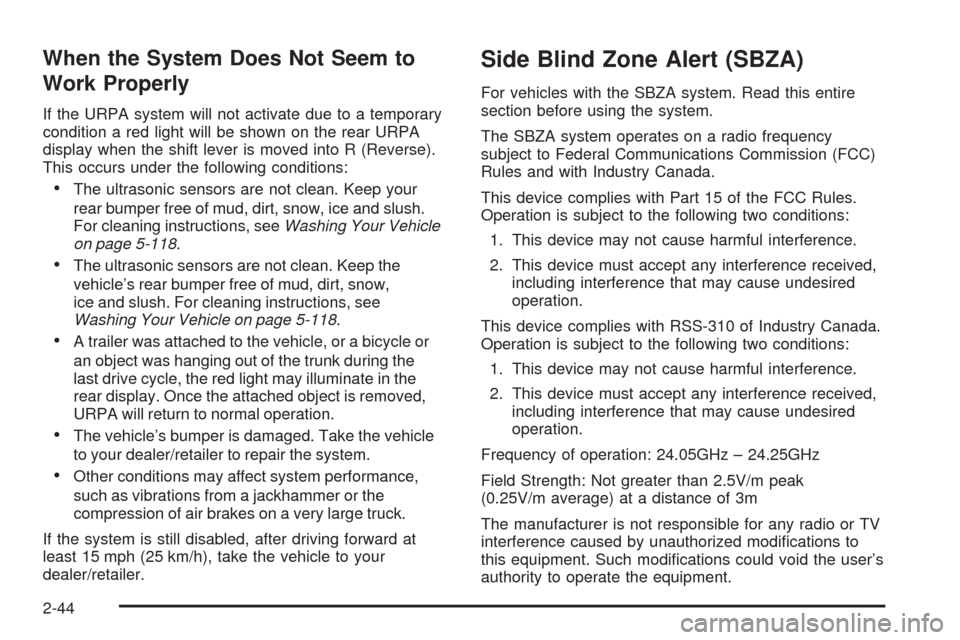
When the System Does Not Seem to
Work Properly
If the URPA system will not activate due to a temporary
condition a red light will be shown on the rear URPA
display when the shift lever is moved into R (Reverse).
This occurs under the following conditions:
The ultrasonic sensors are not clean. Keep your
rear bumper free of mud, dirt, snow, ice and slush.
For cleaning instructions, seeWashing Your Vehicle
on page 5-118.
The ultrasonic sensors are not clean. Keep the
vehicle’s rear bumper free of mud, dirt, snow,
ice and slush. For cleaning instructions, see
Washing Your Vehicle on page 5-118.
A trailer was attached to the vehicle, or a bicycle or
an object was hanging out of the trunk during the
last drive cycle, the red light may illuminate in the
rear display. Once the attached object is removed,
URPA will return to normal operation.
The vehicle’s bumper is damaged. Take the vehicle
to your dealer/retailer to repair the system.
Other conditions may affect system performance,
such as vibrations from a jackhammer or the
compression of air brakes on a very large truck.
If the system is still disabled, after driving forward at
least 15 mph (25 km/h), take the vehicle to your
dealer/retailer.
Side Blind Zone Alert (SBZA)
For vehicles with the SBZA system. Read this entire
section before using the system.
The SBZA system operates on a radio frequency
subject to Federal Communications Commission (FCC)
Rules and with Industry Canada.
This device complies with Part 15 of the FCC Rules.
Operation is subject to the following two conditions:
1. This device may not cause harmful interference.
2. This device must accept any interference received,
including interference that may cause undesired
operation.
This device complies with RSS-310 of Industry Canada.
Operation is subject to the following two conditions:
1. This device may not cause harmful interference.
2. This device must accept any interference received,
including interference that may cause undesired
operation.
Frequency of operation: 24.05GHz – 24.25GHz
Field Strength: Not greater than 2.5V/m peak
(0.25V/m average) at a distance of 3m
The manufacturer is not responsible for any radio or TV
interference caused by unauthorized modi�cations to
this equipment. Such modi�cations could void the user’s
authority to operate the equipment.
2-44
Page 164 of 514
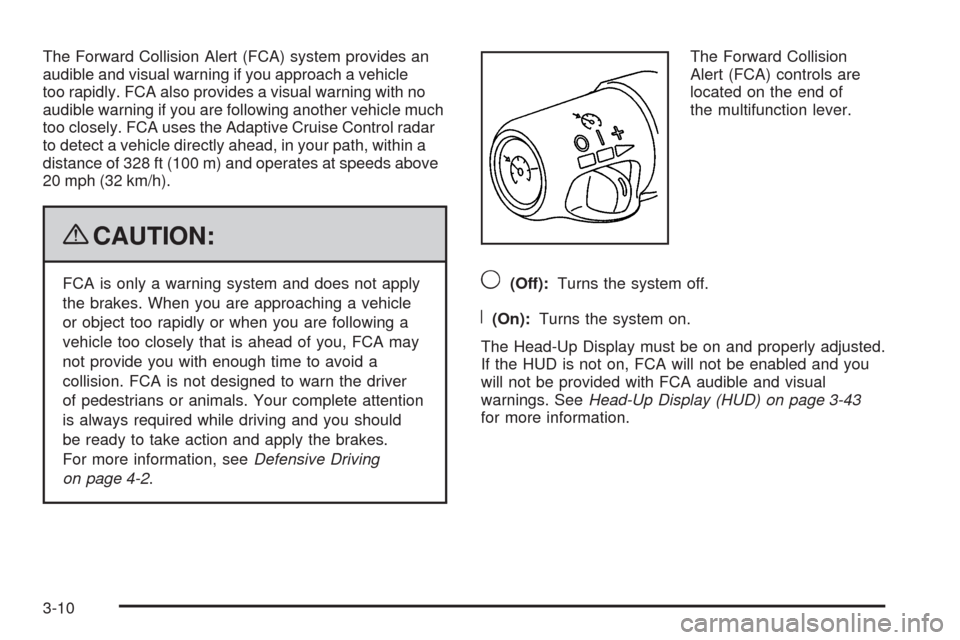
The Forward Collision Alert (FCA) system provides an
audible and visual warning if you approach a vehicle
too rapidly. FCA also provides a visual warning with no
audible warning if you are following another vehicle much
too closely. FCA uses the Adaptive Cruise Control radar
to detect a vehicle directly ahead, in your path, within a
distance of 328 ft (100 m) and operates at speeds above
20 mph (32 km/h).
{CAUTION:
FCA is only a warning system and does not apply
the brakes. When you are approaching a vehicle
or object too rapidly or when you are following a
vehicle too closely that is ahead of you, FCA may
not provide you with enough time to avoid a
collision. FCA is not designed to warn the driver
of pedestrians or animals. Your complete attention
is always required while driving and you should
be ready to take action and apply the brakes.
For more information, seeDefensive Driving
on page 4-2.The Forward Collision
Alert (FCA) controls are
located on the end of
the multifunction lever.9(Off):Turns the system off.
R(On):Turns the system on.
The Head-Up Display must be on and properly adjusted.
If the HUD is not on, FCA will not be enabled and you
will not be provided with FCA audible and visual
warnings. SeeHead-Up Display (HUD) on page 3-43
for more information.
3-10
Page 170 of 514

Headlamp Washer
For vehicles with headlamp washers, they are located to
the inside of the headlamps.
Press
Llocated at the end of the windshield wiper
lever, to wash the headlamps and windshield. After the
�rst wash, the headlamps will be washed after the
�fth press of the windshield washer button.
The headlamps must be on to be washed. If the washer
�uid is low, the headlamp washers will not work.
SeeWindshield Washer on page 3-15for additional
information.
Cruise Control
With cruise control, a speed of about 25 mph (40 km/h)
or more can be maintained without keeping your foot
on the accelerator. Cruise control does not work
at speeds below about 25 mph (40 km/h).
If the brakes are applied, the cruise control shuts off.
{CAUTION:
Cruise control can be dangerous where you cannot
drive safely at a steady speed. So, do not use the
cruise control on winding roads or in heavy traffic.
Cruise control can be dangerous on slippery roads.
On such roads, fast changes in tire traction can
cause excessive wheel slip, and you could lose
control. Do not use cruise control on slippery roads.
If the vehicle is in cruise control when the Traction
Control System (TCS) begins to limit wheel spin or the
stability control system activates, the cruise control
automatically disengages. SeeTraction Control System
(TCS) on page 4-10andStabiliTrak
®System on page 4-6
orEnhanced StabiliTrak®on page 4-6. When road
conditions allow you to safely use it again, the cruise
control can be turned back on.
3-16
Page 174 of 514
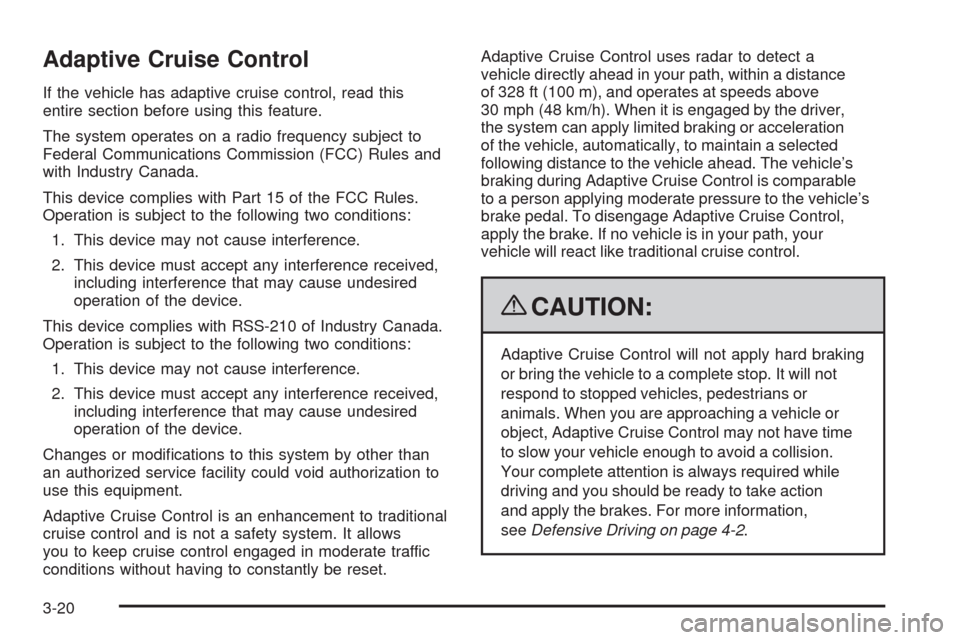
Adaptive Cruise Control
If the vehicle has adaptive cruise control, read this
entire section before using this feature.
The system operates on a radio frequency subject to
Federal Communications Commission (FCC) Rules and
with Industry Canada.
This device complies with Part 15 of the FCC Rules.
Operation is subject to the following two conditions:
1. This device may not cause interference.
2. This device must accept any interference received,
including interference that may cause undesired
operation of the device.
This device complies with RSS-210 of Industry Canada.
Operation is subject to the following two conditions:
1. This device may not cause interference.
2. This device must accept any interference received,
including interference that may cause undesired
operation of the device.
Changes or modi�cations to this system by other than
an authorized service facility could void authorization to
use this equipment.
Adaptive Cruise Control is an enhancement to traditional
cruise control and is not a safety system. It allows
you to keep cruise control engaged in moderate traffic
conditions without having to constantly be reset.Adaptive Cruise Control uses radar to detect a
vehicle directly ahead in your path, within a distance
of 328 ft (100 m), and operates at speeds above
30 mph (48 km/h). When it is engaged by the driver,
the system can apply limited braking or acceleration
of the vehicle, automatically, to maintain a selected
following distance to the vehicle ahead. The vehicle’s
braking during Adaptive Cruise Control is comparable
to a person applying moderate pressure to the vehicle’s
brake pedal. To disengage Adaptive Cruise Control,
apply the brake. If no vehicle is in your path, your
vehicle will react like traditional cruise control.
{CAUTION:
Adaptive Cruise Control will not apply hard braking
or bring the vehicle to a complete stop. It will not
respond to stopped vehicles, pedestrians or
animals. When you are approaching a vehicle or
object, Adaptive Cruise Control may not have time
to slow your vehicle enough to avoid a collision.
Your complete attention is always required while
driving and you should be ready to take action
and apply the brakes. For more information,
seeDefensive Driving on page 4-2.
3-20
Page 177 of 514
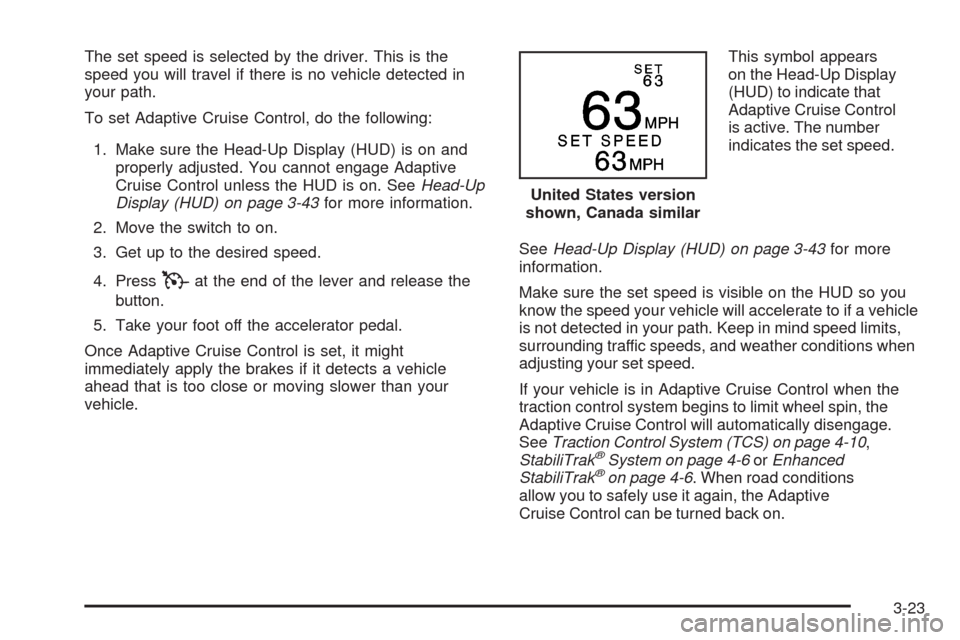
The set speed is selected by the driver. This is the
speed you will travel if there is no vehicle detected in
your path.
To set Adaptive Cruise Control, do the following:
1. Make sure the Head-Up Display (HUD) is on and
properly adjusted. You cannot engage Adaptive
Cruise Control unless the HUD is on. SeeHead-Up
Display (HUD) on page 3-43for more information.
2. Move the switch to on.
3. Get up to the desired speed.
4. Press
Tat the end of the lever and release the
button.
5. Take your foot off the accelerator pedal.
Once Adaptive Cruise Control is set, it might
immediately apply the brakes if it detects a vehicle
ahead that is too close or moving slower than your
vehicle.This symbol appears
on the Head-Up Display
(HUD) to indicate that
Adaptive Cruise Control
is active. The number
indicates the set speed.
SeeHead-Up Display (HUD) on page 3-43for more
information.
Make sure the set speed is visible on the HUD so you
know the speed your vehicle will accelerate to if a vehicle
is not detected in your path. Keep in mind speed limits,
surrounding traffic speeds, and weather conditions when
adjusting your set speed.
If your vehicle is in Adaptive Cruise Control when the
traction control system begins to limit wheel spin, the
Adaptive Cruise Control will automatically disengage.
SeeTraction Control System (TCS) on page 4-10,
StabiliTrak
®System on page 4-6orEnhanced
StabiliTrak®on page 4-6. When road conditions
allow you to safely use it again, the Adaptive
Cruise Control can be turned back on.United States version
shown, Canada similar
3-23
Page 178 of 514
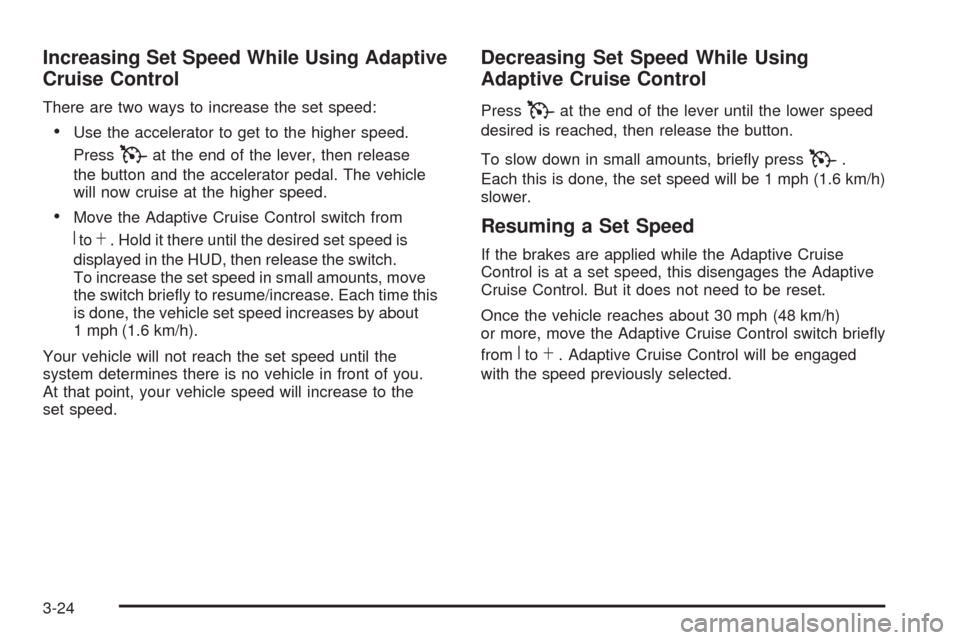
Increasing Set Speed While Using Adaptive
Cruise Control
There are two ways to increase the set speed:
Use the accelerator to get to the higher speed.
Press
Tat the end of the lever, then release
the button and the accelerator pedal. The vehicle
will now cruise at the higher speed.
Move the Adaptive Cruise Control switch from
RtoS. Hold it there until the desired set speed is
displayed in the HUD, then release the switch.
To increase the set speed in small amounts, move
the switch brie�y to resume/increase. Each time this
is done, the vehicle set speed increases by about
1 mph (1.6 km/h).
Your vehicle will not reach the set speed until the
system determines there is no vehicle in front of you.
At that point, your vehicle speed will increase to the
set speed.
Decreasing Set Speed While Using
Adaptive Cruise Control
PressTat the end of the lever until the lower speed
desired is reached, then release the button.
To slow down in small amounts, brie�y press
T.
Each this is done, the set speed will be 1 mph (1.6 km/h)
slower.
Resuming a Set Speed
If the brakes are applied while the Adaptive Cruise
Control is at a set speed, this disengages the Adaptive
Cruise Control. But it does not need to be reset.
Once the vehicle reaches about 30 mph (48 km/h)
or more, move the Adaptive Cruise Control switch brie�y
from
RtoS. Adaptive Cruise Control will be engaged
with the speed previously selected.
3-24
Page 180 of 514
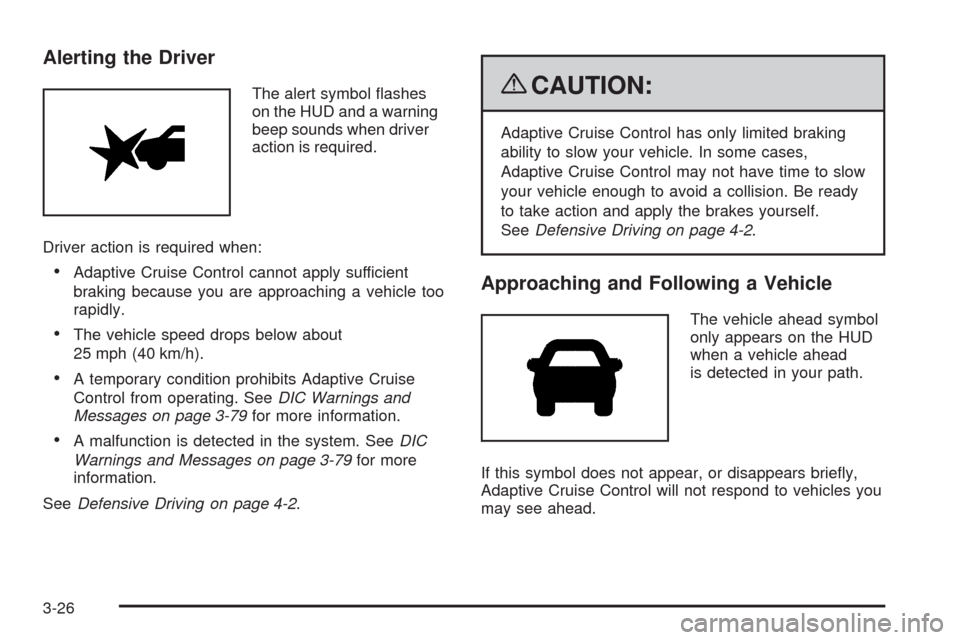
Alerting the Driver
The alert symbol �ashes
on the HUD and a warning
beep sounds when driver
action is required.
Driver action is required when:
Adaptive Cruise Control cannot apply sufficient
braking because you are approaching a vehicle too
rapidly.
The vehicle speed drops below about
25 mph (40 km/h).
A temporary condition prohibits Adaptive Cruise
Control from operating. SeeDIC Warnings and
Messages on page 3-79for more information.
A malfunction is detected in the system. SeeDIC
Warnings and Messages on page 3-79for more
information.
SeeDefensive Driving on page 4-2.
{CAUTION:
Adaptive Cruise Control has only limited braking
ability to slow your vehicle. In some cases,
Adaptive Cruise Control may not have time to slow
your vehicle enough to avoid a collision. Be ready
to take action and apply the brakes yourself.
SeeDefensive Driving on page 4-2.
Approaching and Following a Vehicle
The vehicle ahead symbol
only appears on the HUD
when a vehicle ahead
is detected in your path.
If this symbol does not appear, or disappears brie�y,
Adaptive Cruise Control will not respond to vehicles you
may see ahead.
3-26
Page 181 of 514

{CAUTION:
When the Adaptive Cruise Control radar is blocked
by snow, ice, or dirt, it may not detect a vehicle
ahead. Adaptive Cruise Control may not have time
to slow your vehicle enough to avoid a collision.
Do not use Adaptive Cruise Control when the
radar is blocked by snow, ice, or dirt. Keep your
radar clean. See “Cleaning the System” later in
this section.
Adaptive Cruise Control automatically slows your vehicle
down when approaching a slower moving vehicle. It then
adjusts your speed to follow the vehicle in front at the
selected following distance. Your speed increases or
decreases to follow the vehicle in front of you but will
not exceed the set speed. It may apply limited braking,
if necessary. When braking is active, your brake lights
come on. It may feel or sound different than if you were
applying the brakes yourself. This is normal.
Stationary or Very Slow-Moving Objects
{CAUTION:
Adaptive Cruise Control may not detect and
react to stationary or slow-moving vehicles or
other objects ahead of you. You could crash into
an object ahead of you. Do not use Adaptive
Cruise Control when approaching stationary
or slow-moving vehicles or other objects.
{CAUTION:
Adaptive Cruise Control may not detect and react
to stationary or slow-moving vehicles or other
objects ahead of you. Your vehicle may accelerate
toward objects, such as a stopped vehicle that
suddenly appears after the lead vehicle changes
lanes. Your complete attention is always required
while driving and you should be ready to take
action and apply the brakes.
3-27
Page 182 of 514
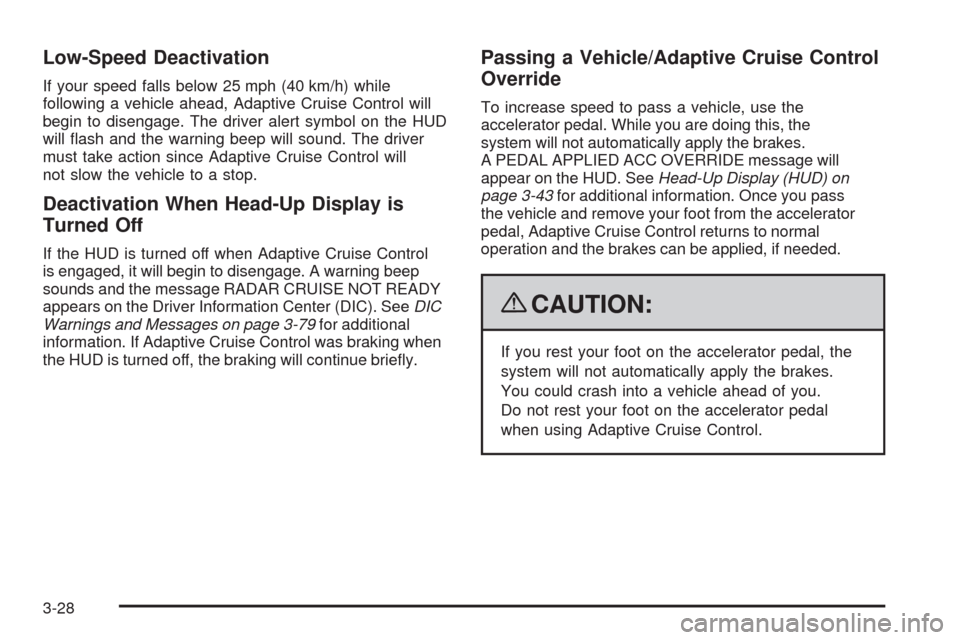
Low-Speed Deactivation
If your speed falls below 25 mph (40 km/h) while
following a vehicle ahead, Adaptive Cruise Control will
begin to disengage. The driver alert symbol on the HUD
will �ash and the warning beep will sound. The driver
must take action since Adaptive Cruise Control will
not slow the vehicle to a stop.
Deactivation When Head-Up Display is
Turned Off
If the HUD is turned off when Adaptive Cruise Control
is engaged, it will begin to disengage. A warning beep
sounds and the message RADAR CRUISE NOT READY
appears on the Driver Information Center (DIC). SeeDIC
Warnings and Messages on page 3-79for additional
information. If Adaptive Cruise Control was braking when
the HUD is turned off, the braking will continue brie�y.
Passing a Vehicle/Adaptive Cruise Control
Override
To increase speed to pass a vehicle, use the
accelerator pedal. While you are doing this, the
system will not automatically apply the brakes.
A PEDAL APPLIED ACC OVERRIDE message will
appear on the HUD. SeeHead-Up Display (HUD) on
page 3-43for additional information. Once you pass
the vehicle and remove your foot from the accelerator
pedal, Adaptive Cruise Control returns to normal
operation and the brakes can be applied, if needed.
{CAUTION:
If you rest your foot on the accelerator pedal, the
system will not automatically apply the brakes.
You could crash into a vehicle ahead of you.
Do not rest your foot on the accelerator pedal
when using Adaptive Cruise Control.
3-28